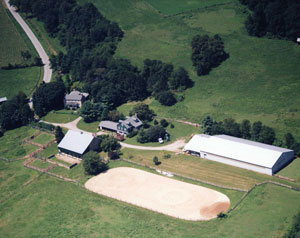[QUOTE=Marla 100;6876925]
I worked on a breeding farm for several years. We had up to 10-12 stallions on the property during that time. This was more a holding area type farm not actual breeding of mares. Unfortunately NONE of those poor horses lived the contented lives that some of the others mentioned previously.
These stallions stayed in standard sized stalls a lot of the time with no turnout but maybe every 2 or 3 weeks they’d go out to the one stallion pen for a few hours. Always turned out alone. Different stallions reacted in different ways to this way of life.
Some got depressed and stood with their head low in the corner- tuning out the world. Some became almost unmanageable and dangerous to handle.
Some stood with their head gazing out the stall window watching other horses, mares, babies frolicking in the sunshine.
Still, to this day I’m sad to think about the lonely, isolated and non -social lives these horses had to endure. Just one of the ugly sides of the horse world.[/QUOTE]
This makes me sad to read, sad for those horses.
I have seen similar situations where the stallions live lives of isolation like this, and when I decided to keep my colt as a stallion prospect one of the main considerations was that I would NOT do it unless the colt/stallion could live a normal and happy life.
My stallion lives in the main barn surrounded by mares and babies. The stall fronts and partitions are only solid at the bottoms, the upper part are widely spaced bars - so the stallion can see and socialize while in the barn. He has a colt beside him, but mares in all the other stalls.
The paddocks and pastures on my farm are in a loose pie or star pattern around the barn.
He is turned out in all weather, every day, in a large pasture (about 4 acres) which is separated by a tractor aisle from the pasture adjacent, which has the colt and his pony companion in it.
When the pony chooses, he climbs through the fence into the aisle and visits with the stallion. :rolleyes:
Sometimes this same pasture will have mares/mares and foals in it.
Other times he goes out into a smaller paddock, which is adjacent to all the other paddocks, each with a couple of mares in them. He stares, he trots around, he surveys his kingdom, but mostly he eats and sleeps in the sunshine.
One of his fencelines is shared with my neighbours and their 8! homeschooled children. Right along the fence line is their play structure, their trampoline and their pool.
Often I will look out to and see the stallion grazing calmly only a few feet away from all the children playing and screaming.
He comes in at night, but is out for between 4-10hrs daily, weather dependant.
So, while he does not share his paddock with another horse, he is not isolated or lonely in any way.
He seems to be very happy, very content and secure. and able to be left in the barn alone, or left outside alone, for whatever reasons, (farrier or vet coming etc).
When he was actively showing, and living at the trainer’s, he was on the same turnout schedule as all the other horses, turned out individually (as they all were) but beside his friends.


 The easiest stallion either my husband or I ever handled. And it wasn’t a fluke, he did the same with his next hand breeding too.
The easiest stallion either my husband or I ever handled. And it wasn’t a fluke, he did the same with his next hand breeding too.
